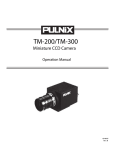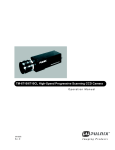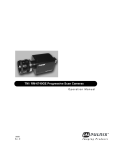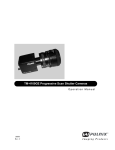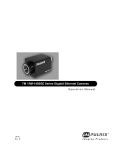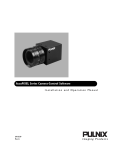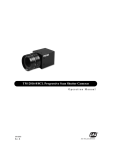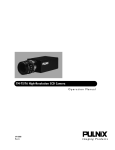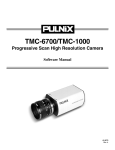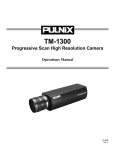Download Pulnix TM-6703 Instruction manual
Transcript
TM-6703 Progressive Scan Double Speed Shutter Camera Operation Manual 69-0061 Rev. A Notice The material contained in this manual consists of information that is proprietary to PULNiX America, Inc., and may only be used by the purchasers of the product. PULNiX America, Inc. makes no warranty for the use of its product and assumes no responsibility for any errors which may appear or for damages resulting from the use of the information contained herein. PULNiX America, Inc. reserves the right to make changes without notice. Warranty All of our solid state cameras have a full three-year warranty. If any such product proves defective during this warranty period, PULNiX America, Inc. will repair the defective product without charge for parts and labor or will provide a replacement in exchange for the defective product. This warranty shall not apply to any damage, defect or failure caused by improper use or inadequate maintenance and use. Certifications CE Compliance The TM-6703 has been certified to conform to the requirements of Council Directive 89/336/EC for electromagnetic compatibility and to comply with the following European Standards: Immunity: EN500082-2/1995 Emissions: EN55022:1995 Class A / CISPR 22:1993 All PULNiX products bearing the CE mark have been declared to be in conformance with the applicable EEC Council Directives. However, certain factory installed options or customer requested modifications may compromise electromagnetic compatibility and prohibit use of the CE mark. Please note that the use of interconnect cables that are not properly grounded and shielded may affect CE compliance. Contact the PULNiX Applications Engineering Department for further information regarding CE compliance. FCC This equipment has been tested and found to comply with the limits for a Class A digital device, pursuant to Part 15 of the FCC Rules. These limits are designed to provide reasonable protection against harmful interference when the equipment is operated in a commercial environment. This equipment generates, uses and can radiate radio frequency energy and, if not installed and used in accordance with the instruction manual, may cause harmful interference to radio communications. Operation of this equipment in a residential area is likely to cause harmful interference in which case the user will be required to correct the interference at his own expense. WARNING Changes or modifications to this unit not expressly approved by the party responsible for FCC compliance could void the user’s authority to operate the equipment. TM-6703 Operation Manual Printing:April 26, 1999 PULNiX America, Inc. 1330 Orleans Drive Sunnyvale, CA 94089 Tel: (408) 747-0300 Tel: (800) 445-5444 Fax: (408) 747-0880 E-mail: [email protected] www.pulnix.com Table of Contents 1 INTRODUCTION 1.1 1.2 1.3 Product Description .......................................................................... 1 Features ........................................................................................... 1 Functional Options ........................................................................... 3 2 INSTALLATION 2.1 2.2 3.2 ..................................................................... 4 Getting Started ................................................................................. 4 2.1.1 Unpacking Instructions ........................................................ 4 2.1.2 Components List ................................................................. 4 2.1.3 Accessories ......................................................................... 4 Camera Setup .................................................................................. 5 2.2.1 Connector Pin Configurations ............................................. 5 2.2.2 Rear Panel .......................................................................... 5 2.2.3 Power Supply and Power Cable Setup ................................ 5 2.2.4 Attaching the Video Output ................................................. 7 2.2.5 Attaching the Camera Lens ................................................. 7 2.2.6 Back Focusing the Lens ...................................................... 7 2.2.7 Auto Iris Lens Setup ............................................................ 8 2.2.8 Non-Interlace Black & White Monitors ................................. 8 3 OPERATION 3.1 .................................................................... 1 .......................................................................... 9 Modes of Operation .......................................................................... 9 3.1.1 Asynchronous Reset Mode ................................................. 9 3.1.2 Driving /VINIT ...................................................................... 10 3.1.3 Shutter Control Switch ........................................................ 11 3.1.4 Progressive Scanning ......................................................... 14 3.1.5 Option 7-2 ........................................................................... 15 3.1.6 V-Sync Output Selection for Async Mode (OP51-2) ............ 15 3.1.7 Integration ........................................................................... 16 3.1.8 External Input Signals ......................................................... 16 Board Layout and Adjustment .......................................................... 17 3.2.1 Top Board (Top Side) .......................................................... 17 3.2.2 Bottom Board (Bottom Side) ............................................... 17 4 TROUBLESHOOTING 4.1 4.2 ........................................................... 18 Problems and Solutions ................................................................... 18 4.1.1 Symptom: No Video ............................................................. 18 4.1.2 Symptom: Dark Video .......................................................... 18 4.1.3 Symptom: Non-synchronized Video .................................... 18 Information and Support Resources ................................................ 19 i Table of Contents 5 APPENDIX 5.1 5.2 5.3 5.4 .............................................................................20 Specifications ................................................................................... 20 5.1.1 Product Specifications ......................................................... 20 5.1.2 Physical Dimensions ............................................................ 21 5.1.3 Glass Specifications ............................................................ 22 5.1.4 C-Mount Specifications ........................................................ 22 5.1.5 Front End Detail ................................................................... 23 Spectral Response ........................................................................... 24 Block Diagram .................................................................................. 24 Timing Chart ..................................................................................... 25 5.4.1 Pixel Mapping (Horizontal) ................................................... 25 5.4.2 Vertical Frame Output Timing .............................................. 25 ii List of Figures FIGURE 1. TM-6703 System Configuration FIGURE 2. 12P-02 Interface Cable (optional) FIGURE 3. Asynchronous Reset FIGURE 4. VINIT (Vertical Initialization) Trigger Specifications FIGURE 5. Equivalent Circuit FIGURE 6. External Pulse Width Control (Async Mode) FIGURE 7. Internal Fast Reset ..................................................................... 12 FIGURE 8. Internal Slow Reset .................................................................... 13 FIGURE 9. Scan Output ............................................................................... 15 FIGURE 10. I/O Jumpers ................................................................................ 15 FIGURE 11. Integration Timing FIGURE 12. Internal Input Signals ................................................................. 16 FIGURE 13. Physical Dimensions .................................................................. 21 FIGURE 14. Camera Front End - Glass Specifications FIGURE 15. Combination With “CS-Mount” Camera FIGURE 16. TM-6703 Imager Location FIGURE 17. Spectral Response FIGURE 18. TM-6703 Block Diagram FIGURE 19. Pixel Mapping (Horizontal) FIGURE 20. Vertical Frame Output Timing iii ................................................. 3 .............................................. 6 .................................................................. 9 .................... 10 ....................................................................... 10 .............................. 12 ....................................................................... 16 .................................. 22 ...................................... 23 .......................................................... 23 ..................................................................... 24 ............................................................. 24 ......................................................... 25 ..................................................... 25 April 22, 1999 TM-6703 Progressive Scan Double Speed Shutter Camera Operation Manual 1 INTRODUCTION 1.1 Product Description The TM-6703 is a high resolution monochrome camera with three scanning modes: Non-interlace double speed scanning VGA format (60Hz); two-row scanning (120Hz); and partial scanning (100 and 200 lines). Features include compact size, rugged construction, double speed scan, asynchronous reset and electronic shutter, non-interlace 60Hz analog video (VGA), and partial scanning. The double speed mode is standard, thus the images can be displayed on a standard VGA monitor. Applications include high speed image capturing, machine vision, computer graphics, gauging, avionics, microscopy, character and fine pattern recognition, document reading and high end surveillance. 1.2 Features • 1/2" progressive scan interline transfer CCD Advantages include: - 648H x 484V active pixels for very high resolution and superior image quality Square pixels (9.0 x 9.0 µm) for precise dimensional measurements Double speed scanning Partial scan capability allows 120Hz two-row scanning (combining two lines), 100 and 200 lines of partial scan as well as 60Hz frame scanning. All images are centered in the video frame - High speed electronic shutter capability results in high dynamic resolution of moving objects - Progressive scanning eliminates interlace image deterioration - High sensitivity and low noise at fast scanning, excellent S/N ratio (>50db) Page 1 INTRODUCTION • Asynchronous reset The TM-6703 resets with an external reset pulse (VINIT). This feature is especially important for capturing moving objects at a precise location in the field of view, for applications such as a conveyer belt process, fast event observation, and still picture capturing. • Integration The TM-6703 is capable of capturing high resolution integration images. Integration can last from 1/60 sec. to several seconds. • VGA display output The TM-6703’s VGA output scans out at 60Hz non-interlace. Because the double speed mode is standard, images can be displayed on a standard VGA monitor. PULNiX PVM-1200 series monitors or equivalent B/W multi-sync monitors can be used to display non-interlace images. Please contact your PULNiX representative for display monitor information. • Sync input (external sync) or output (clock and sync) selection (optional, OP7-2)) Rear board jumpers enable sync input/output selection. When the jumpers are set to internal sync, the camera accepts HD and VD sync and video output from pin #4 of the 12-pin connector. If the jumpers are set to OP7-2, then HD, VD and clock output are provided for a frame grabber to take the data. • “One shot sync” (optional, OP51-2) The composite sync of the video output can be selectable with the rear panel jumper (resistor location). Continuous V-sync mode outputs the V-sync at all times regardless of async reset or normal rate V-sync during async mode stand-by. Async V-sync mode outputs the V-sync once only at async reset (at Vinit trigger) and no V-sync during the stand-by period (H-sync only in video composite sync) until the next Vinit comes in. These modes can be selected based on a frame grabber’s sync capability for async reset. • Three-Year Warranty The CCD solid state image sensor allows the camera to maintain a superior performance level indefinitely while requiring virtually no maintenance. PULNiX backs all of the TM Series cameras with a three-year warranty. WARNING: Page 2 Unscrewing the camera cover or opening the camera in any way will void this warranty. TM-6703 Progressive Scan Double Speed Shutter Camera INTRODUCTION 1.3 Functional Options FIGURE 1. • Optical Filter Removal (OP3-2) • Glassless CCD Imager (OP21) • Internal IR Filter (OP3-1) • Pixel Clock, HD, and VD output (OP7-2) • One Shot Sync (OP51-2) • Remote Head (OP10-1) TM-6703 System Configuration Power External Sync Integration Video Output* VIDEO SHUTTER 9 0 1 2 8 3 7 6 5 4 PULNiX Multi-Sync Monitor (PVM-1242 or PVM-942) ASY N O MAN P T GAIN POWER Computer with Frame Grabber Board (if required) * Video Output is the same as BNC connector Note: Additional cable interface may be required from the frame grabber board manufacturer. TM-6703 Progressive Scan Double Speed Shutter Camera Page 3 INSTALLATION 2 INSTALLATION The following instructions are provided to help you to set up your video camera system quickly and easily. It is suggested that you read through these instructions prior to unpacking and setting up your camera system. 2.1 Getting Started 2.1.1 Unpacking Instructions It is recommended that the original packing cartons for the cameras and lenses be saved in case there is a need to return or exchange an item. It is also recommended that any equipment being sent to another location for field installation be bench tested to assure that everything is fully operational as a system. 2.1.2 Components List Please begin by checking your order against the Components List (below) to assure that you have received everything as ordered, and that nothing has been overlooked in the packing materials. If any item is missing, please contact your PULNiX representative immediately. • TM-6703 camera • TM-6703 data sheet • TM-6703 manual (by request) 2.1.3 Accessories Following is a list of additional accessories or equipment that may be recommended or required for your particular application. Please check with your PULNiX representative prior to the installation of your video system to determine what you might need. Page 4 • Cable (power/video) 12P-02 • PVM-1242 or PVM-942 multi sync monitor • Power supply PD-12P TM-6703 Progressive Scan Double Speed Shutter Camera INSTALLATION 2.2 Camera Setup 2.2.1 Connector Pin Configurations 2.2.1 (a) 12-Pin Connector 1 2 The TM-6703 has a 12-pin connector for power input. Description Pin# 8 10 3 Pin# 9 11 7 12 Description 1 GND 7 VD in (out OP7-2) 2 +12V DC 8 GND 3 GND 9 HD in (out OP7-2) 4 Video Out (clk out OP7-2) 10 N/C 5 GND 11 Integration 6 VINIT In 12 GND 4 6 5 2.2.2 Rear Panel PULNiX Functions and controls located on the camera rear panel: • 12-pin connector (power, I/Os) • BNC video cable connector • Shutter speed selection dial • ASY/MAN switch (asynchronous shutter and manual shutter switch) • N/P and O/T switches (scanning mode selection) • Manual gain control adjustment VIDEO SHUTTER 9 0 1 2 8 3 7 6 5 4 ASY N O MAN P T GAIN POWER Rear Panel 2.2.3 Power Supply and Power Cable Setup 2.2.3 (a) Power Supplies PULNiX recommends the following power supplies: K25-12 110V AC/12V DC 2.1A power supply P-15-12 220V AC/12V DC 2.1A power supply K50-12 110V AC/12V DC 4.2A power supply PD-12P 110V AC/12V DC 0.5A power supply For users providing power through the 12-pin connector, the PD-12P power supply is available with the 12-pin mating connector already attached to the leads from the power supply. The PD-12 power supply can be connected to the PULNiX power cable via a terminal strip or directly. TM-6703 Progressive Scan Double Speed Shutter Camera Page 5 INSTALLATION If wiring the PD-12 power supply directly, please note the following • Twist the lead ends together and tin solder for strength and electrical continuity • Use shrink tubing or a similar insulator to prevent exposed leads from touching • The +12V lead is marked with a red stripe or white lettering; be sure not to reverse the leads • Properly insulate all connections to prevent shorting 2.2.3 (b) Using PULNiX Power/Video Cables If you are using PULNiX power cables, such as the 12P-02, KC-10, etc., please refer to the pin-out diagram. The color coded leads use Grey for Ground and Yellow for +12V DC. FIGURE 2. 12P-02 Interface Cable (optional) Flying Leads 32mm 1 2,000mm± 10mm (2 Meters) 1 PC-12P (Hirose Part #10A-10P-12S/PC12P) 12P-02 Interface Cable Note: Pin# Lead Color Function Pin# Lead Color Function 1 Gray GND 7 Black coax VD Input 2 Yellow +12VCD 8 White coax shield GND 3 Red coax shield GND 9 White coax HD Input 4 Red coax Video 10 Brown N/C 5 Orange coax shield GND 11 Blue Integration 6 Orange coax N/C 12 Black coax shield N/C Make sure that the unused leads are not touching and that there is no possibility that the leads could short due to exposed wires. 2.2.3 (c) Using the “K” Series Power Supplies Attach the 110V line cord to the two terminals marked “AC”. Do not plug the cord into a 110V AC socket until later in the procedure. Next, attach the Grey and Yellow leads of the power cable to the Ground and 12V DC terminals respectively. Be sure to replace the plastic terminal guard on the power supply at this time. Page 6 TM-6703 Progressive Scan Double Speed Shutter Camera INSTALLATION Note: The “K” series power supplies are designed primarily for OEM users who will be mounting the power supply inside a protective enclosure. For use in exposed situations, the DC-12N and PD-12 are recommended. 2.2.3 (d) Building Your Own Power Cables If you are building your own power cables, consult the pin-out for the camera purchased and connect the Ground and +12V power leads of the PC-12P power connector to Pin #1 and Pin #2, respectively (power must be DC regulated, and of sufficient current to properly power the camera). 2.2.3 (e) Attaching the Power Cable to the Connector The 12-pin connector is keyed and will only fit in one orientation. Rotate the connector while applying slight pressure until the keyways line up. Press the connector into place until firmly seated. The power cord may now be plugged into the 100V AC socket, and the camera powered up. 2.2.4 Attaching the Video Output Most users utilize the BNC connector for video output from the camera. Connect the output from the camera to the input of your monitor, VCR or switching device. The input of the monitor should be balanced for 75Ω termination. Standard RG-59 type coaxial cable should carry a full video signal for up to 500 feet. Users wishing to output the video and input the power and sync to a camera over a single cable can use the PULNiX multi-conductor cables, such as the 12P-02, the KC-10, etc. The mini coaxial leads in PULNiX multi-conductor cables are designed for short runs of no longer than 100 feet. Note: Make sure that no extraneous wires are visible which could cause a short. 2.2.5 Attaching the Camera Lens The TM-6703 camera accepts standard C-mount lenses. To attach the C-mount lens to the camera, carefully engage the threads and rotate the lens clockwise until it firmly seats on the mounting ring. Do not force the lens if it does not seat properly. Please note that some lenses with extremely long flangebacks may exceed the mounting depth of the camera. 2.2.6 Back Focusing the Lens To backfocus the TM-6703 camera, first attach a C-mount lens in the lens mount. Be sure that the lens is properly mounted. Set the lens focus to infinity (if the lens is a manual iris, set the iris to a high f-stop while still retaining a well-illuminated image). Obtain the best focus possible at this setting, then loosen the two miniature hex head set screws (hex socket size: 0.89mm) locking the focus ring in place. Now turn the entire lens and focus ring assembly back and forth until the best image is obtained. Tighten the focus ring set screws. Your backfocus is now set. TM-6703 Progressive Scan Double Speed Shutter Camera Page 7 INSTALLATION 2.2.7 Auto Iris Lens Setup Auto-iris lenses with full video input (1 Vpp) can be used with the PULNiX TM-6703, although this camera model does not come equipped with auto-iris output. Note: Make sure that the power is removed from the camera before connecting or disconnecting the auto-iris lens. There is a small chance that damage could occur to the auto-iris lens by plugging or unplugging it while the camera is powered up. To install the auto-iris lens in a PULNiX camera for which the auto-iris output is not supplied, wire the signal (video) on the lens into the terminal 1 Vp to peak video output on the camera (pin 4 of 12 pin connector). Point the camera at a light area and then quickly towards a darker area. If everything is working properly, the iris should adjust for the light change. 2.2.8 Non-Interlace Black & White Monitors The PULNiX PVM-942 / 1242 non-interlace black and white monitor, or an equivalent model, can be used to display the TM-6703’s various display modes. In standard operation, including RS-170 interlace, 60 Hz non-interlace, 30 Hz non-interlace and 120 Hz non-interlace (two-row scanning mode), the display is normal. In the partial scanning mode, the vertical extends to fill the monitor screen and the images will be distorted vertically. Page 8 TM-6703 Progressive Scan Double Speed Shutter Camera OPERATION 3 OPERATION 3.1 Modes of Operation The TM-6703 is designed to accommodate a high resolution, on-line inspection reset mechanism with full frame shutter. It accepts external horizontal sync (HD, TTL Levels) to lock the camera and VINIT pulse for resetting the camera asynchronously. The shutter speed can be controlled by either an external double pulse, or by internal speed control by setting the 10-position shutter speed dial switch on the back panel. 3.1.1 Asynchronous Reset Mode For the asynchronous reset mode, select ASY on the back panel of the camera. The TM-6703's asynchronous reset is flexible. External HD can be applied for phase locking if required. Applying a VINIT pulse resets the camera's scanning and purging of the CCD. Do not supply VD if the asynchronous reset is used. Instead, use HD to synchronize the camera to the external device. When external VINIT is high (5V), the TM-6703 expects the async pulse input and the video output will be black video. It resets at the negative going pulse edge and captures the frame regardless of the shutter speed (fast or slow mode). The video output is kept disabled as the CCD is discharged continuously during VINIT high. When the first VINIT pulse comes in, it resets the timing and outputs the image. If the switch is set to NRM (normal mode), the video output will be real time with manual shutter. FIGURE 3. Asynchronous Reset EXTERNAL VINIT ASYNC RESET INTERNAL VD SG (TRANSFER GATE) DISCHARGE PULSES NON-INTERLACE OUTPUT VIDEO SHUTTER VIDEO TM-6703 Progressive Scan Double Speed Shutter Camera Page 9 OPERATION 3.1.2 Driving /VINIT The TM-6703 VINIT input circuit equivalently has 10K ohm input resistance (Figure 4, “VINIT (Vertical Initialization) Trigger Specifications,” on page 10). To drive this circuit, at least 0.5mA of current is required to drive the camera. Note: FIGURE 4. The VINIT signal must be a defined, clean pulse for the asynchronous reset function to work properly. Some triggering systems (e.g., optical isolators, mechanical relays, noisy electrical devices, etc.) have bounce or rapid transition between high and low states. It is highly recommended that the input VINIT pulse be analyzed by test equipment to ensure proper signal characteristics. If an unspecified signal is used, improper camera performance may result. VINIT (Vertical Initialization) Trigger Specifications +5V TTL Level t 0V t Min. 2H Max. 500H H = 31.8µs Note: PULNiX does not recommend voltage levels less than standard 0 to 5 V. FIGURE 5. Equivalent Circuit VINIT 10K Page 10 TM-6703 Progressive Scan Double Speed Shutter Camera OPERATION Position Manual Shutter Mode Async Reset Mode 0 No Shutter No Shutter 1 1/125 1.0H 1/32,000 2 1/250 2.0H 1/16,000 3 1/500 4.0H 1/8,000 4 1/1,000 8.0H 1/4,000 5 1/2,000 16.0H 1/2,000 6 1/4,000 32.0H 1/1,000 7 1/8,000 64.0H 1/500 8 1/16,000 128.0H 1/250 9 1/32,000 Mode 0: Mode 1-4: Mode 5-8: Mode 9: Note: 78 9 01 2 3 The shutter control switch is located on the rear panel of the camera. The dial can be set from 0 to 9. The settings are detailed below. 4 56 3.1.3 Shutter Control Switch Shutter determined by pulse width Normal Mode Fast Mode Slow Mode Pulse Width Mode Manual shutter speeds lower than 1/1,000 (i.e., longer in duration) are not applicable for partial scan due to the short frame rate. 3.1.3 (a) External Pulse Width Control Mode To select the External Pulse Width Control mode, set the shutter speed dial switch to “9”. Apply a pulse width control VINIT signal to the camera via an external event trigger. The internal reset pulse will be latched to HD. At the 9th HD timing from the external pulse leading edge (negative going edge), the CCD discharge pulse will be generated to clear the images. The internal VD is generated at the following edge (positive going edge) of the external pulse, and resets the internal timing, including the video sync. The shutter speed will be the same as the external pulse width, but the integration delays 9H from the leading edge of the external pulse width. For the immediate reset option, please contact PULNiX. One frame of video output will start from the rising edge of the pulse width control for progressive format. The camera will output the same video from memory when VINIT is kept high (5V), and update the image upon receiving the next pulse. At async mode, with external pulse input high, the video output is disabled as the camera keeps discharging the CCD image and only will provide black video. TM-6703 Progressive Scan Double Speed Shutter Camera Page 11 OPERATION FIGURE 6. External Pulse Width Control (Async Mode) X External Pulse Width VINIT HD Internal VD 9H Transfer Gate Pulse 9H X Exposure Time Discharge pulse Composite Video 3.1.3 (b) Internal Fast Reset Mode (Async Mode) For Internal Reset Mode, set the 10-position dial switch from “1” to “4”. When this mode is selected, the camera resets with internal VD timing, which is latched to Hd, and video output is also synchronized with internal VD timing without further delay. The shutter speed is controlled by the dial switch. FIGURE 7. Internal Fast Reset External pulse VINIT min. 2H HD Internal VD 9H Transfer Gate Pulse Exposure Time Purge pulse (discharge) Composite Video Page 12 TM-6703 Progressive Scan Double Speed Shutter Camera OPERATION 3.1.3 (c) Internal Slow Reset Mode (Async Mode) For Internal Slow Reset Mode, set the 10-position shutter speed dial switch from “5” to “8”. When the external VINIT pulse is applied, internal VD is latched to Hd and a second internal VD signal is generated to set up the shutter speed period. Video output timing starts right after the second internal VINIT. FIGURE 8. Internal Slow Reset External pulse VINIT min. 2H HD Internal VD 9H Transfer Gate Pulse 9H Discharge pulse EXPOSURE TIME Composite Video TM-6703 Progressive Scan Double Speed Shutter Camera Page 13 OPERATION 3.1.4 Progressive Scanning The TM-6703 uses a state-of-the-art CCD called a “Progressive scanning interline transfer CCD” which scans all lines sequentially from top to bottom at one frame rate (60 Hz). Like a non-interlace computer screen, it generates a stable crisp image without alternating lines and provides full vertical TV resolution of 484 lines. The interline transfer architecture is also important to generate simultaneous shuttering. This is different from full frame transfer architecture which requires a mechanical shutter or strobe light in order to freeze the object motion. The TM-6703 outputs the progressive scanned image with an electronic shutter in three different modes. These modes are selected via the switches on the rear panel of the camera. TABLE 1. Scanning Mode Settings Normal Mode N O (60Hz progressive scan) Double Scan N T (120Hz progressive scan) 100 Line Scan P O (200Hz progressive scan) 200 Line Scan P T (125Hz progressive scan) 1. Progressive scanning double speed output (Normal mode. Select N, O) 2. On the rear panel of the camera, select NRM (normal mode), N and O. This produces straight forward signal output equivalent to non-interlace VGA format (60Hz). Real-time double speed CCD output is converted through normal analog video processing into 75Ω 1Vp-p output format. Progressive scanning 120Hz output (Rear switches: N, T) 3. This mode provides 120Hz scanning of the full field of view, but with only 242 lines of vertical resolution. The CCD signals of each row combine to scan 242 lines; the frame speed therefore is 120Hz of non-interlace video. The async reset, electronic shutter and integration function work as normal. The analog output is the same as 75Ω, 1Vp-p format at the 120Hz rate. Partial scanning output (Rear switches: P, T for 100 lines; P, O for 200 lines) By selecting 100 line partial scan (P, T), the TM-6703 outputs the central 100 lines of video. It repeats the same lines at a rate of 200 frames/sec. with the fast dump blanking of unused lines. The asynchronous reset and electronic shutter functions are maintained at each partial scan. By selecting 200 line partial scan (P, O), the TM-6703 outputs the central 200 lines of video at a rate of 125 frames/sec. The partial scan keeps the same resolution as full progressive scan, but with a narrower field of view. Page 14 TM-6703 Progressive Scan Double Speed Shutter Camera OPERATION FIGURE 9. Scan Output Center of Image Normal scan VD Partial scan VD (partial scan) Center 100 lines Fast dump 3.1.5 Option 7-2 In order to connect the TM-6703 camera to various frame grabbers, internal jumper settings allow the TM-6703 to accept external HD and VD sync at double speed (fH = 31.468 KHz), or to output HD, VD and pixel clock for variable scan frame grabbers. This option can be requested when ordering the TM6703. FIGURE 10. I/O Jumpers CLOCK W1 W2 VIDEO W`1 (VD) OUT IN W12 Last connection not used; do not OUT connect to this IN position. W2 (HD) BOTTOM BOARD, TOP SIDE REAR BOARD (FACING INWARD) Standard settings (inputs) Output set 3.1.6 V-Sync Output Selection for Async Mode (OP51-2) At async image capturing, some frame grabbers cannot take the specific frame when continuous video sync presents. The TM-6703 video output is normally composite sync with frame rate V-sync regardless of the actual image or blank image.When it is asynchronously reset, the newly reset V-sync may be random to normal sync rate and can be very close to the regular rate V-sync. This may be problematic to the frame grabber in capturing the correct image.By selecting the rear plate board jumper, the V-sync output occurs only at the async reset, and no V-sync occurs until the next Vinit (async trigger) comes in. The frame grabber can then look for this V-sync and capture the correct timing. TM-6703 Progressive Scan Double Speed Shutter Camera Page 15 OPERATION 3.1.7 Integration Integration times can vary depending on the specific application. Pin #11 of the 12-pin connector is integration control. It accepts standard TTL inputs. High is considered 5 volts, and Low is considered 0 volts. When a low is applied to pin #11, the integration process begins. Integration blocks the transfer gate of the image data out of the CCD array. Upon returning the signal back to high (which is required to end the process). the image is output upon the next regular transfer. FIGURE 11. Integration Timing Vertical Sync. (VD) 1 ( VD freq.)sec CCD Transfer (SG) 1 ( VD freq.)sec 1 ( VD freq.)sec 9H 1 ( VD freq.)sec 1 ( VD freq.)sec 1 ( VD freq.)sec Integration Signal Example #1 yields 2 frames of exposure Integration Signal Example #2 yields 3 frames of exposure NOTE: Integration may be controlled in increments of frame times only. H = 1/horizontal frequency. When the integration signal is set back to high (5 volts), the image data will not move out of the CCD array until the transfer gate occurs. Sg’s occur 9H after the start of the VD. For example, if the camera is set to expose for 1.5 frame times, the actual exposure is for 2 frame times because the array is still accumulating light until the sg of that field (or frame if field mode). The remaining image data acquired before the start of the integration may also be output. NOTE: The camera should be in normal mode during integration. 3.1.8 External Input Signals FIGURE 12. Internal Input Signals 1/HD frequency +5Volts HD TTL Level 0 Volts 1 - 2µsec. 1/VD frequency +5Volts VD TTL Level 0 Volts 1 to 9H Page 16 TM-6703 Progressive Scan Double Speed Shutter Camera OPERATION 3.2 Board Layout and Adjustment 3.2.1 Top Board (Top Side) W5 W6 W7-W9 VR1 VR2 back plate VR3 VR4 VR5 VR7 AGC/MGC Left: AGC Right: MGC Gamma Down: On (0.45) Up: Off (1.0) CDS pulse delay adjustment AGC MGC Set at 2.0V Controlled from AGC MAX PED RG Vsub Set at 2.5V Set at 50 mV of video Factory adjustment only Factory adjustment only VSUB AGC MAX GAMMA PED RG 3.2.2 Bottom Board (Bottom Side) ASY MAN VR2 PLL adjustment W1 (VD), W2 (HD) HD and VD input/output selection PLL TM-6703 Progressive Scan Double Speed Shutter Camera Page 17 TROUBLESHOOTING 4 TROUBLESHOOTING 4.1 Problems and Solutions Following are troubleshooting tips for common problems. Generally, problems can be easily solved by following these instructions. If the following remedies fail to offer a solution to your problems, please contact a PULNiX representative. 4.1.1 Symptom: No Video Remedies: Check that the following are properly connected and operational. • Power supplies • Power cables • Main power source • Shutter control • Async mode • Lens 4.1.2 Symptom: Dark Video Remedies: Check that the following are properly connected and operational. • Shutter selection • Iris opening on the lens • Async mode (with 5 volt level at Pin #6) 4.1.3 Symptom: Non-synchronized Video Remedies: Check that the following are properly connected and operational. Page 18 • Proper mode output • Frame grabber software camera selection TM-6703 Progressive Scan Double Speed Shutter Camera TROUBLESHOOTING 4.2 Information and Support Resources For further information and support: Phone: (408) 747-0300 (800) 445-5444 (800) 3-PULNIX (24-hour message access) Fax: (408) 747-0660 E-mail: [email protected] Mail: PULNiX America Inc. Sales Department 1330 Orleans Drive Sunnyvale, CA 94089 ATTN: Video Applications Web Site: www.pulnix.com TM-6703 Progressive Scan Double Speed Shutter Camera Page 19 APPENDIX 5 APPENDIX 5.1 Specifications 5.1.1 Product Specifications TABLE 2. Product Specifications Table Imager Pixels Cell size Photosensitive Pixels 694 H x 496 V 9.0 H x 9.0 V µm 648 H x 484 V Output sensitivity 12µV/e- Micro lens Standard Scanning 525 lines at 60Hz (double speed mode) Sync Pixel clock TV resolution Min. illumination Video output Display mode video S/N ratio Internal/External auto switch HD/VD, 4.0 Vp-p impedance 4.7KΩ fHD = 31.468KHz / fVD = 60Hz 25.49MHz 500 H x 484 V 2.0 lux, f = 1.4 without IR cut filter Analog 1.0 Vp-p composite video, 75Ω, sync negative non-interlace Analog only fHD=31.468KHz, fVD=60Hz (VGA) 50dB min AGC = OFF, 56dB typical AGC On / Off (off = std) MGC Manual gain adjustable (6dB to 26dB) Gamma Lens mount Power requirement Operating temp. Vibration & Shock Size Weight Power cable Power supply Page 20 1/2" progressive scan interline transfer CCD with on-chip microlens 0.45 or 1.0 (1.0=std) C-mount 12 V DC 500 mA -10°C to +50°C Vibration: 7Grms (10Hz to 2000Hz), Shock: 70G 46.1mm x 39.4mm x 140.0mm (1.78" x 1.52" x 5.41") 240 grams (9.0 oz.) 12P-02 K25-12V or PD-12 TM-6703 Progressive Scan Double Speed Shutter Camera APPENDIX 5.1.2 Physical Dimensions Physical Dimensions FIGURE 13. 140.8 mm 46.3 mm 128.1 mm VIDEO PULNiX 39.4 mm SHUTTER 9 0 1 2 8 3 7 6 5 4 ASY N O MAN P T GAIN POWER 7.0 mm 40 mm 2x 11.0 mm 1/4-20 UNC-2B 2x M3 x 8 30.4 mm TM-6703 Progressive Scan Double Speed Shutter Camera 2x M6x1 Page 21 APPENDIX 5.1.3 Glass Specifications FIGURE 14. Camera Front End - Glass Specifications CCD Glass Cover CCD Glass CCD Glass (BK-7) 0.75mm thickness Refractive Index = 1.5 Glass Cover (BD-65) 1.0mm thickness Refractive Index = 1.51 5.1.4 C-Mount Specifications The Flange Back Length of the “CS-Mount” is 12.5mm versus 17.526 of the “C-Mount”. The shorter Flange Back Length of the “CS-Mount” allows room for the stripe filter incorporated in the color camera. Additionally, the shorter Flange Back Length allows for reduction of the effective diameter of the first lens and reduces the number of lens elements. The common C-Mount lens is completely compatible with a CS-Mount camera when a 5mm extension ring is inserted between the lens and the camera. Page 22 TM-6703 Progressive Scan Double Speed Shutter Camera APPENDIX FIGURE 15. Combination With “CS-Mount” Camera CS-Mount Lens Focal Point 5mm Extension Ring C-Mount Lens 5 12.5 17.526 Flange Surface of C-Mount 5.1.5 Front End Detail FIGURE 16. TM-6703 Imager Location TM-6703 Progressive Scan Double Speed Shutter Camera Page 23 APPENDIX 5.2 Spectral Response FIGURE 17. Spectral Response 1.0 0.9 0.8 Relative Sensitivity 0.7 0.6 0.5 0.4 0.3 0.2 0.1 0 300 400 500 600 700 800 900 1000 1100 Wave Length (nm) 5.3 Block Diagram FIGURE 18. TM-6703 Block Diagram CCD TIMING GEN. Page 24 CDS & AMP SYNC GEN. SYNC ADDED PLL/XTAL VIDEO EXT. HD TM-6703 Progressive Scan Double Speed Shutter Camera APPENDIX 5.4 Timing Chart 5.4.1 Pixel Mapping (Horizontal) FIGURE 19. Pixel Mapping (Horizontal) HORIZONTAL RESET 45 TOTAL CLOCK PER 1H = 810 pixels 740 738 ACTIVE PIXEL 116 117 O.B. 10 11 DUMMY 1 764 738 739 740 741 DUMMY O.B. 60 CCD OUTPUT BLANK 202 PIXEL CLOCK OPTICAL BLACK ACTIVE PIXEL OPTICAL BLACK 694 691 690 682 35 683 DUMMY 34 11 1 10 CCD LINE CONTENT DUMMY 5.4.2 Vertical Frame Output Timing FIGURE 20. Vertical Frame Output Timing VD 9H TOTAL HORIZONTAL SCANNING = 525H 484 484 ACTIVE PIXELS 30 1 8 O.B. 4 484 1 HORIZONTAL LINES 4 O.B. 11H VIDEO OUTPUT BLANK = 41H 3H 3H 35H NORMALMODE 479 480 481 482 483 484 PARTIAL SCAN (VARIABLE) EXAMPLE 100 LINE SCAN FAST DUMP 2.5 x (488-100) µsec 3H 3H 3H 200 LINE SCAN 199 200 TM-6703 Progressive Scan Double Speed Shutter Camera 3H 2 3 1 2 3 1 2 3 35H 99 100 FAST DUMP 2.5 x (488-200) µsec 1 35H Page 25 , Industrial Products Division PULNiX America, Inc. 1330 Orleans Drive Sunnyvale, CA 94089 Tel: 408-747-0300 Tel: 800-445-5444 Fax: 408-747-0660 Email: [email protected] www.pulnix.com































